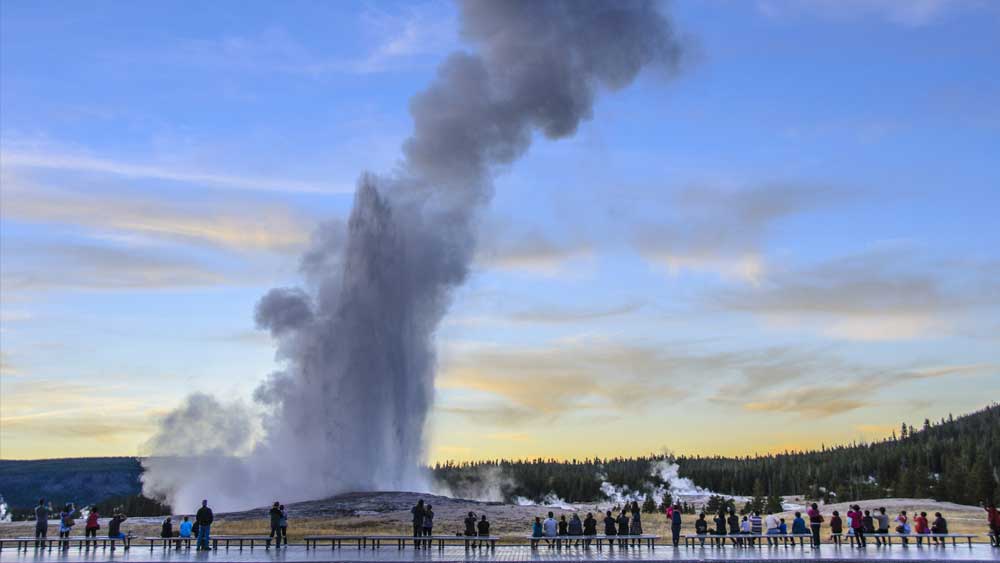This brought on more speculation and fear of another supervolcano eruption that would have the potential of impacting most of the United States. This area of Yellowstone has already shown two similar rises in ground elevation in the recent past, but has subsided each time.1 Modeling of geophysical data suggested that magma came within 9 miles of the surface below the geyser basin between 1996 and 2004.1 As stated in the London Daily,
When magma intrudes the crust it cools, crystallizes, and releases gases that had been dissolved in the melt. Gas escape lowers pressure in the magma, causing the surface to subside... But rising gases can become trapped under an impermeable layer of rock, causing the kind of rapid uplift seen at Norris from late 2013 until the [magnitude] 4.9 earthquake in March 2014.1
Dan Dzurisin, a member of the science team monitoring the elevation of the land over Norris Geyser Basin, said, “It seems likely the quake created microfractures that allowed gases to escape upward again, resulting in subsidence that ended in 2015.” This ended the second active episode.1
Dzurisin further reported,
The third uplift episode from 2016 to 2018 suggests rising gases became trapped again, this time at a slightly shallower depth. For the first time, we've been able to track an entire episode of magma intrusion, degassing, and gas ascent to the near-surface.1
How does all of this factor into the big picture of Yellowstone? And should we be concerned about a major volcanic eruption?
Today, we see an ocean ridge system coming north up the Gulf of California (along the Baja Peninsula) and a second ocean ridge system off the west coast of Washington and Oregon, creating the subduction zone there and the Cascade Mountains. These two ridge systems are connected through the San Andreas Fault system. The former section of the ridge system between them has been subducted beneath North America.
A subducted ridge system tends to be more buoyant and exerts pressure upward on the base of the continent. This might provide a cause for the basement-cored mountain ranges so far inland from the subduction zone that existed along the West Coast. Kelleher and McCann first noticed this off the west coast of South America where ridges have been subducted nearly horizontally beneath the continent for hundreds of kilometers.2
A subducted ridge system so far inland beneath North America could also explain the trail of the Yellowstone Hot Spot from Oregon to northwest Wyoming in the Cenozoic. This line of volcanism parallels the northern edge of the ridge system that was subducted beneath North America. The highest point of the ridge system may have funneled magma along the crest of the subducted ridge, like the peak of a tent, releasing vast quantities of magma to “burn” a hot spot trail through the overlying crust. In similar fashion, the Yellowstone supervolcano eruptions could also be a consequence of the pooling of magma beneath the subducted ridge. But, keep in mind, these eruptions only occurred in the receding phase of the Genesis Flood.
Not even all secular scientists are concerned about a major eruption at Yellowstone either. And of course, they believe the last supervolcano eruption occurred about 600,000 years ago.1
“For those in the know, like you, that's awesome—not alarming,” Dzurisin explained.1
One thing we can be assured of: God is in control. We do not need to fear another supervolcano eruption at Yellowstone. These past eruptions were part of the global Flood year, about 4,500 years ago. It should be no surprise that magma is still close to the surface there, as evidenced by the geysers and geophysical data. A small eruption could occur, but not a massive supervolcanic eruption that would destroy much of our nation. These eruptions were part of a special judgment as recorded in the book of Genesis. We do not need to live in fear of that today.
References
1. Liberatore, S. Huge chunk of Yellowstone National Park ‘breathing’ in and out due to trapped magma. London Daily News. Posted on dailymail.co.uk March 20, 2020, accessed March 25, 2020.
2. Kelleher, J., and W. McCann. 1976. Buoyant zones, great earthquakes, and unstable boundaries of subduction. Journal of Geophysical Research. 81(26): 4885-4896.
*Dr. Clarey is Research Associate at the Institute for Creation Research and earned a Ph.D. in geology from Western Michigan University.













